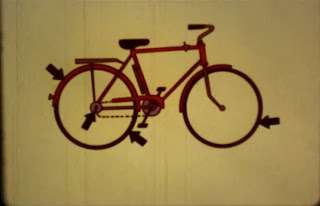

In I'm No Fool With a Bicycle from 1955 (released in color in 1956) the conscientious pedagogue Jiminy Cricket gives a short history of the bicycle, and explains some of the basics of safe riding. The 8 min. film was part of an "I'm No Fool" safety series that aired on the original Mickey Mouse Club TV show in the 1950s. In fact, the bicycle safety film was the very first in that series, which also included lessons on fire, water, pedestrians, and more.
I'm No Fool With a Bicycle begins like the other films in the I'm No Fool series (in fact, most of the opening animated footage is exactly the same from one film to the next as a cost-cutting method), which is to say, it begins with Jiminy Cricket surrounded by books in a library, singing the very catchy song "I'm No Fool" that should be absolutely familiar to anyone old enough to remember Annette, Tommy, Cubby, and the rest of the original Mouseketeers.
I'm no fool! No-sir-ee!
I'm gonna live to be a hundred and three.
I play safe for you and me,
'Cause I'm no fool!
That song was written by Disney songwriter Jimmie Dodd, and sung by Cliff Edwards, who did the voice of Jiminy Cricket from the 1940 film Pinocchio, and up until the late 1960s. By the way - songwriter Dodd also wrote the Jiminy Cricket song "Encyclopedia E-N-C-Y-C-L-O-P-E-D-I-A" which was so catchy that to this day I (and perhaps an entire generation of baby boomers before me) cannot spell the word "encyclopedia" without singing it.
Jiminy then goes on to talk about doing things the right way and the wrong way, and how only fools do things the wrong way. Not until he opens up a book about bicycles does the animated footage become specific to this particular film, otherwise the opening sequence all got recycled in the other safety films in the series.
Jiminy's history lesson fills up the rest of the first half of the film:
 |
| "It was very popular if you overlooked the problems of getting on - and getting off." You just know this guy's going to end up doing a face plant. |
 |
| There he goes . . . |
 |
| "Even today in many countries, it is the chief means of transportation for the entire family." |
The next half of the film follows the oft-used "Goofus and Gallant" formula using little chalkboard characters to represent "You" the viewer . . .
And a "common, ordinary fool":
Jiminy then illustrates various rules about riding by praising "You" doing things right, while we get to laugh at the fool doing everything wrong.
 |
| "Remember, a bicycle is to You what a motor car is to a grownup." There you have it - and don't forget it. |
 |
| "You" ride with your hands on the bars, your wheels on the ground, use hand signals, stay to the right, and don't show off. |
 |
| The fool doesn't take care of his bicycle, rides no-hands, disobeys rules, and shows off -- and we're told he won't live long. |
All the while, Jiminy sings more bicycle-specific verses of the "I'm No Fool" song.
 |
| As Jiminy criticizes the fool, he says things that would never get past today's sensitivity police, saying things like, "OK, Nitwit" and "Try it again, Stupid." |
And that's the end of the film, but there's still more to mention.
Apart from it's significance as a bicycle safety film, I'm No Fool With a Bicycle has other points of interest worth discussing. For one thing, it represented a shift in Walt Disney's operations as they made the transition from full-length animation and short films for the big screen to shorts for the new, burgeoning medium of television. Working on tighter schedules for TV meant finding ways to save time as well as cutting costs (hence the use of so much "recycled" animation footage in things like the I'm No Fool series). The animation style also had to become much less detailed - flatter, and simpler, with bolder outlines -- making Jiminy easier for audiences to make out on their smaller, often grainy TV screens.
 |
| Jiminy in 1940 - Pinocchio |
 |
| Jiminy in 1955 - I'm No Fool. And yes, Jiminy did become more of a caucasion-toned cricket for 1950s television audiences. |
Lastly, this film, along with several others in the series, was re-made and re-released in 1988, combining some of the old parts with newer live-action footage. And of course, the updated (and twice as long) version made sure to push bicycle helmets. I can't seem to find a copy of the updated version, however.
In the meantime, put on your mouse ears and cast yourself back to the '50s and watch I'm No Fool With a Bicycle (courtesy of Hbvideos on YouTube):
Oh, Annette, where are you when I need you?






No comments:
Post a Comment